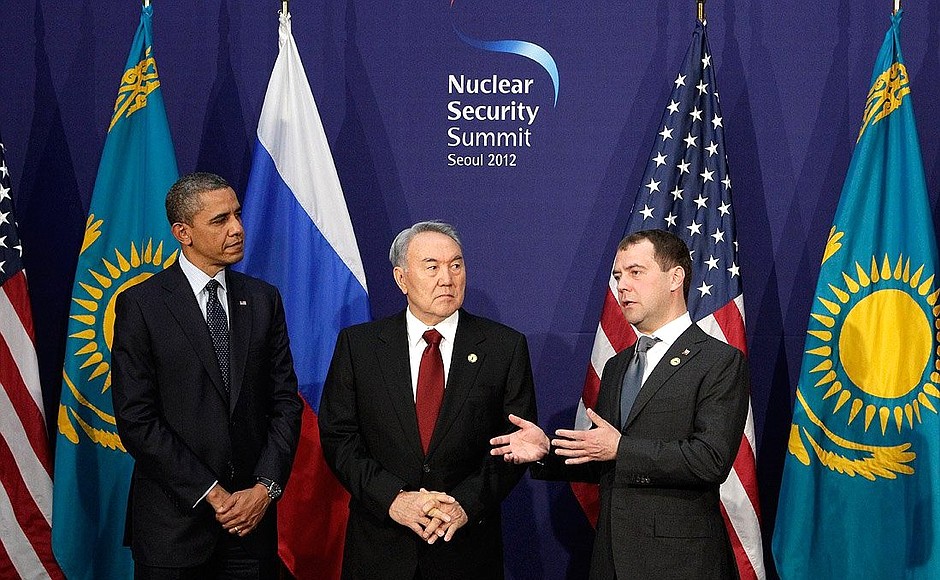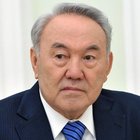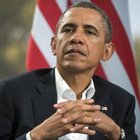
***
President of Kazakhstan Nursultan Nazarbayev: As all of you know, the Semipalatinsk nuclear test site was one of the largest test sites in the world, along with the nuclear test site in Nevada. 500 nuclear tests were carried out there, including more than 70 in the open air.
After the site was closed by my decree 20 years ago, Kazakhstan, Russia and the United States have been engaged in joint efforts on the elimination of the consequences, the rehabilitation of the test site and the destruction of the infrastructure. Since 2004 we have rehabilitated 3,000 square kilometres of the territory (the test site occupied 40,000 square kilometres, and half million people were affected by the radiation).
This is a positive example of collaboration between states, first, on the rehabilitation and, secondly, on strengthening security and the non-proliferation of nuclear materials. We, the people of Kazakhstan, are grateful to Russia and the United States for such assistance.
As you know, earlier we eliminated ballistic missile silo launchers with 1,100 warheads in the same way. We also worked together on destroying the infrastructure and precluding the possibility of these materials’ distribution.
I would like to use this occasion to express our country’s deep gratitude and hope for further cooperation on this issue.
President of The United States of America Barack Obama: I’m just going to make a very brief statement here. We wanted to do this brief appearance to highlight one of the most significant examples of what we have been doing through this Nuclear Security Summit and what our three countries have been able to accomplish through some painstaking cooperation over the last several years. As the President of Kazakhstan indicated, this was a major site for nuclear operations during the Cold War. There was a lot of loose nuclear material that was vulnerable to potential smuggling, to potential infiltration. And as a consequence of extraordinary cooperation between our three countries that actually predates my administration, but was accelerated as a consequence of this Nuclear Security Summit, we’ve been able to effectively lock down and secure all this vulnerable material.
We have been able to do this in part because of the outstanding leadership of President Nazarbayev and the people of Kazakhstan. We’ve also been able to do it because the United States and Russia over the last several years have shown ourselves to have a mutual interest in making sure that the nuclear materials are secure and that they do not fall into the wrong hands.
This kind of multilateral cooperation is being duplicated as a consequence of this Nuclear Security Summit and it gives you a specific example of the kind of progress that we’re making. We’re going to make more progress over the next several years but I’m confident that we can actually meet the goal that we set in the first Washington summit, which is in four years to have made extraordinary progress in making sure that loose nuclear material is not vulnerable to smuggling or to potential terrorist plots.
President of Russia Dmitry Medvedev: Summits are held not only for leaders to meet, shake hands and express good intentions, but also to demonstrate concrete examples of cooperation. Here is one such example: since 2004, Kazakhstan, the United States and Russia have been engaged in eliminating the consequences of the Semipalatinsk nuclear test site use. We are aware of the threats created by preserving the site’s former functions, as my colleagues have just said.
Today we can say that all these threats have been eliminated and the Semipalatinsk test site exists in a completely different role. Now Kazakhstan can develop the area and look into the future with confidence. I think this is an excellent example of cooperation between our three states.
I would like to thank my colleague President of Kazakhstan Nursultan Nazarbayev for his proactive stance and for creating the necessary conditions for this work. I would also like to note that the Russian Federation and the United States, as countries that bear a special responsibility for nuclear security, have provided the necessary assistance in this matter. Despite the fact that all this is a consequence of previous ideological approaches, we have found the necessary financial and human resources to jointly address this problem and resolve it.
I think this is a good example of cooperation and such examples should be multiplied. This is a positive example for other countries to engage in nuclear security issues and mitigate the consequences of the past.
<…>

